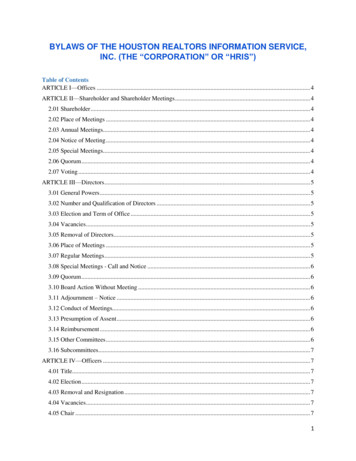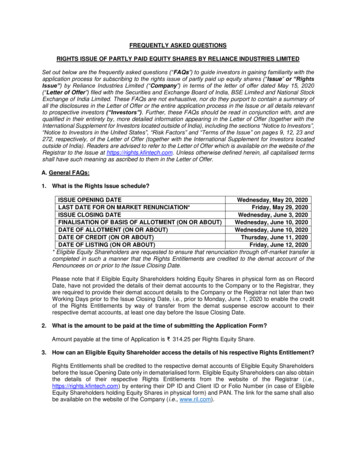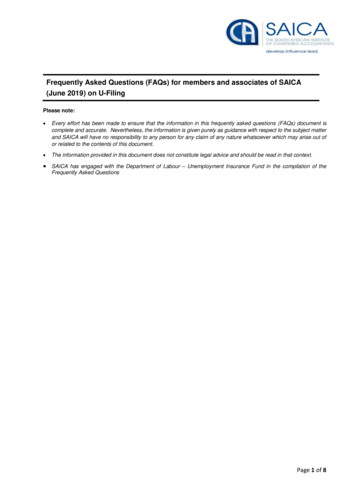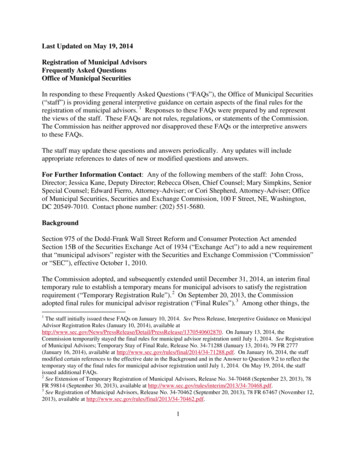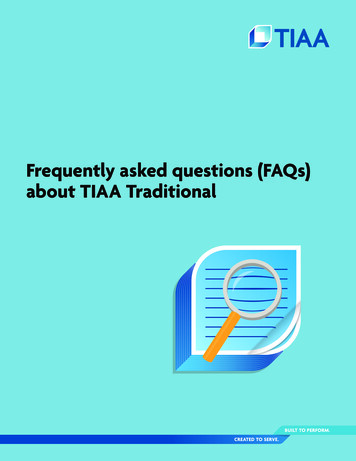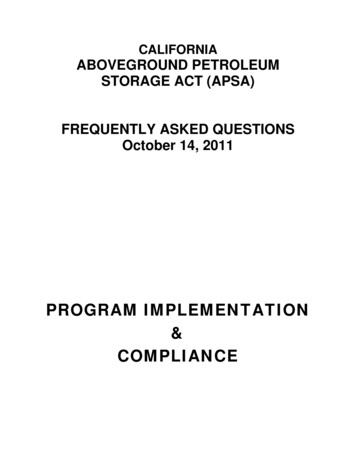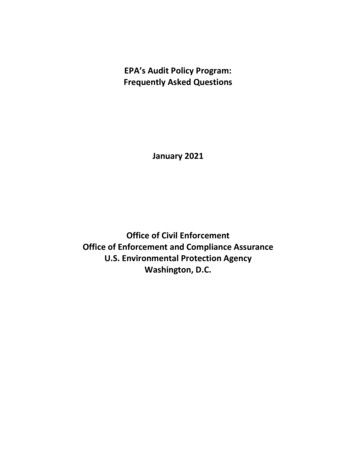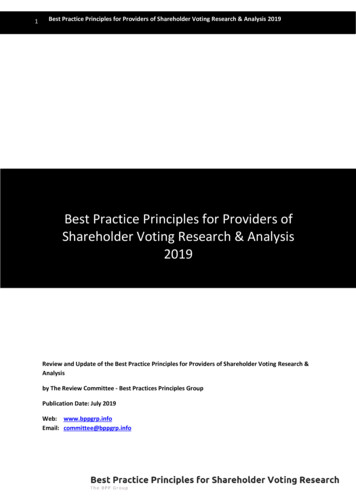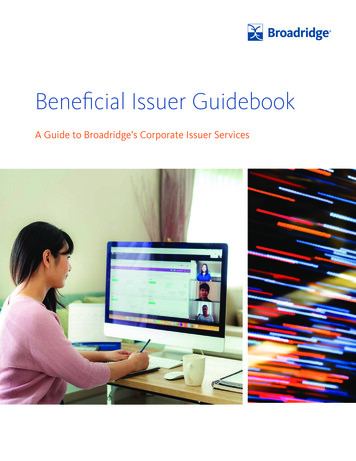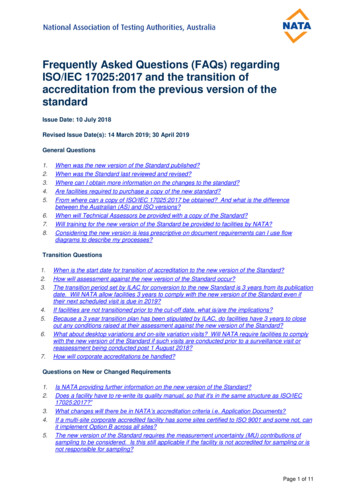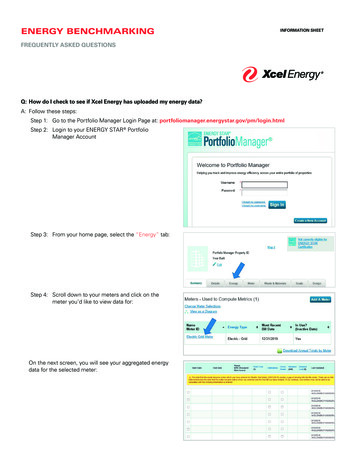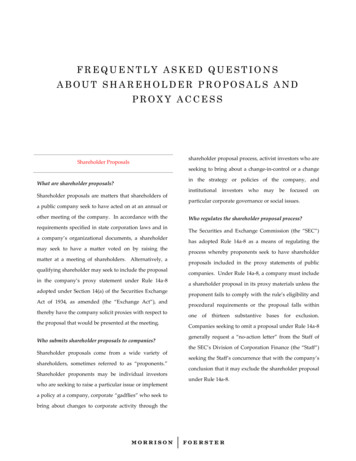
Transcription
FREQUENTLY ASKED QUESTIONSABOUT SHAREHOLDER PROPOSALS ANDPROXY ACCESSShareholder Proposalsshareholder proposal process, activist investors who areseeking to bring about a change-in-control or a changeWhat are shareholder proposals?in the strategy or policies of the company, andinstitutionalShareholder proposals are matters that shareholders ofinvestorswho maybefocusedonparticular corporate governance or social issues.a public company seek to have acted on at an annual orother meeting of the company. In accordance with therequirements specified in state corporation laws and ina company’s organizational documents, a shareholdermay seek to have a matter voted on by raising thematter at a meeting of shareholders. Alternatively, aqualifying shareholder may seek to include the proposalin the company’s proxy statement under Rule 14a-8adopted under Section 14(a) of the Securities ExchangeAct of 1934, as amended (the “Exchange Act”), andthereby have the company solicit proxies with respect tothe proposal that would be presented at the meeting.Who submits shareholder proposals to companies?Who regulates the shareholder proposal process?The Securities and Exchange Commission (the “SEC”)has adopted Rule 14a-8 as a means of regulating theprocess whereby proponents seek to have shareholderproposals included in the proxy statements of publiccompanies. Under Rule 14a-8, a company must includea shareholder proposal in its proxy materials unless theproponent fails to comply with the rule’s eligibility andprocedural requirements or the proposal falls withinone of thirteen substantive bases for exclusion.Companies seeking to omit a proposal under Rule 14a-8generally request a “no-action letter” from the Staff ofthe SEC’s Division of Corporation Finance (the “Staff”)Shareholder proposals come from a wide variety ofshareholders, sometimes referred to as “proponents.”Shareholder proponents may be individual investorswho are seeking to raise a particular issue or implementa policy at a company, corporate “gadflies” who seek tobring about changes to corporate activity through theseeking the Staff’s concurrence that with the company’sconclusion that it may exclude the shareholder proposalunder Rule 14a-8.
The Scope of Rule 14a-8WhatarethesubstantiverequirementsunderRule 14a-8?Does Rule 14a-8 require that all shareholder proposalsUnder paragraph (i) of Rule 14a-8, a company maybe included in a company’s proxy statement?exclude a shareholder proposal from its proxy materialsUnder Rule 14a-8, a company must include ashareholder proposal in its proxy materials unless theproponent fails to comply with the rule’s eligibility andprocedural requirements, or the proposal meets one ofthe thirteen substantive bases for exclusion specified inthe rule.if the proposal falls into one of thirteen specificsubstantive bases for exclusion. These substantive basesrepresent areas that the SEC has determined over theyears not to be appropriate matters for consideration byshareholders through the shareholder proposal process.To exclude a proposal, a company must first notify theSEC, which is typically done through a request for aWhat are the eligibility and procedural requirements“no-action” letter.for shareholder proposals under Rule 14a-8?company may argue that the subject shareholderRule 14a-8 imposes several eligibility and proceduralproposal can be excluded under more than one basis forrequirements on shareholders who rely on the rule.exclusion.Among other things, a shareholder may only submitone proposal per meeting, must have owned at leastIn the no-action letter request, aHow does the no-action letter process work withrespect to shareholder proposals? 2,000 or 1% of securities entitled to vote on theproposal for one year and must limit its proposal to500 words. A shareholder must submit the proposal atleast 120 days before the anniversary date of thecompany's proxy statement for the previous year'sannual meeting (or a reasonable time before thecompany begins to print and mail its proxy materials ifthe company did not have an annual meeting duringthe previous year, or if the date of the annual meetinghas been changed by more than 30 days from the date ofthe previous year's annual meeting). A company thatintends to rely on the rule to exclude a proposal mustsubmit its “no-action” request 80 days in advance of thedate that it proposes to file its definitive proxymaterials.The central component of the Rule 14a-8 process is theno-action letter.A no-action letter is a letter from theStaff that provides the Staff’s informal view regardingwhether it would recommend enforcement action to theSEC if the company takes the course of action describedin the no-action request (i.e., exclusion of the proposalfor a particular reason(s) enumerated in Rule 14a-8).No-action letters reflect the Staff’s views concerning theapplication of securities laws to a particular set of facts.In the context of Rule 14a-8, no-action letters often serveas a key hurdle for shareholders that hope to include aproposal in a company’s proxy materials.There is no rule that requires the submission ofno-action requests, nor is there a rule that requires thatthe Staff respond to such requests. Companies submitrequests to comply with Rule 14a-8(j), which requiresthat companies “file their reasons” with the SEC. TheMorrison & Foerster LLP2
Staff responds to such requests as a convenience to bothHow does a proponent demonstrate that the ownershipcompanies and shareholders, and in order to assist bothrequirements have been satisfied?companies and shareholders in complying with theUnder Rule 14a-8(b), prior to the company’s deadlineproxy rules. While the Staff’s no-action letters typicallyfor proposals, the shareholder must prove eligibility byaddress whether the company has a basis to exclude thebeing a record holder of the securities that the companyproposal, there also may be times when the Staff willcould verify on its own, or, if the shares are held insay that there appears to be some basis for thestreet name, by submitting either:company’s objection, but the problem can be cured ifA written statement from the record holder ofthe proponent changes the proposal in some specificthe securities (usually a broker or bank that isway, for example, the proponent makes a mandatorya Depositaryproposal into a nonbinding proposal, or deletes certainTrustCompany(“DTC”)participant) verifying that, as of the date thewords or sentences in the proposal to avoid vagueness.shareholdersubmitstheproposal,theSome companies have elected to submit a notice to theshareholder continuously held at least 2,000SEC of the company’s intention to exclude the proposal,in market value or 1% of the company’sand then file suit in federal court seeking a declaratorysecurities entitled to vote on the proposal atjudgment as to whether the proposal may be excludedthe meeting for at least one year by the date theunder Rule 14a-8.shareholder submitted the proposal; or The Eligibility and Procedural RequirementsA copy of a Schedule 13D, Schedule 13G,Form 3, Form 4, Form 5, or amendments tothose documents or updated forms, reflectingof Rule 14a-8the shareholder’s ownership of the shares as ofWhat are the requirements as to ownership foror before the date on which the one-yeareligibility period begins, together with asubmitting shareholder proposals?statement that confirms the shareholder hasA shareholder proposal may be submitted underRule 14a-8 by a proponent who has held at least 2,000held the shares continuously for at leastone year.worth of the company’s stock (or 1% of the sharessmaller)In Staff Legal Bulletin No. 14F (“SLB 14F”), the Staffcontinuously for at least one year before the date theclarified that only DTC participants should be viewedproposal is submitted to the company.Further, theas “record” holders of securities that are deposited withproponent must hold the securities through the date ofDTC. In accordance with this guidance, a shareholderthe annual meeting and agree to present (or have athat owns shares through a broker or bank that is not aqualified representative present) the proposal at theDTC participant must obtain and submit two proof ofmeeting.ownership statements—one from the ker or bank confirming the shareholder’s beneficialownership and one from the DTC participant throughMorrison & Foerster LLP3
which the securities are held confirming the recordIs there particular language that a proponent shouldownership of the shareholder’s broker or bank.have its broker or bank use when providing the proof ofRule 14a-8(b)(2)(i) provides that, in addition to theownership information?proof of ownership, “You [the shareholder proponent]SLB 14F suggests that a shareholder proponent use themust also include your own written statement that youfollowing format to have its broker or bank provide theintend to continue to hold the securities through therequired proof of ownership as of the date thedate of the meeting of shareholders.”shareholder plans to submit the proposal: “As of [datethe proposal is submitted], [name of shareholder] held,What must a company do if it wants to exclude aproposal for failure of the proponent to provideadequate proof of ownership?and has held continuously for at least one year, [numberof securities] shares of [company name] [class ofsecurities].”A company that seeks to exclude a shareholderproposal from its proxy materials on the basis of proofHow does a proponent determine the market value ofof ownership must take at least the following steps:the securities held for the purposes of eligibility to(i) determine whether the shareholder is a registeredsubmit a proposal under Rule 14a-8?shareholderregisteredThe Staff noted in Staff Legal Bulletin No. 14 (“SLB 14”)shareholders; (ii) review the proof of ownership to seethat, in order to determine whether the shareholderif the bank or broker providing such proof is a DTCsatisfies the 2,000 threshold, the Staff looks at whether,participant by comparing such bank or broker’s nameon any date within the 60 calendar days before the dateagainst the list of DTC participants; and (iii) if the bankthe shareholder submits the proposal, the shareholder’sor broker is not a DTC participant, notify theinvestment is valued at 2,000 or greater, based on theshareholder and request that the shareholder obtain aaverage of the bid and ask prices. If bid and ask pricessecond letter demonstrating proof of ownership fromare not available, then the market value is determinedthe bank or broker that is a DTC participant throughby multiplying the number of securities the shareholderwhich the other bank or broker holds shares.held for the one-year period by the highest selling pricebycheckingitslistofIn Staff Legal Bulletin No. 14G (“SLB 14G”), the Staffduring the 60 calendar days before the shareholderstated the view that, for purposes of Rule 14a-8(b)(2)(i),submitted the proposal.a proof of ownership letter from an affiliate of a DTCsecurity’s highest selling price is not necessarily theparticipant satisfies the requirement to provide a proofsame as its highest closing price.of ownership letter from a DTC participant.The Staff notes that that aHow many proposals may a shareholder proponentsubmit?Under Rule 14a-8(c), a proponent may submit no morethan one proposal for a particular shareholders’meeting.Morrison & Foerster LLP4
How long can a shareholder proposal be?proxy statement released to shareholders in connectionUnder Rule 14a-8(d), the proposal, including anywith the previous year’s annual meeting. The deadlineaccompanying supporting statement, may not exceedfor shareholder proposals for the next annual meeting is500 words.included in the company’s proxy statement, and isThe Staff notes, in SLB 14, that any statements whichare arguments “in support of the proposal” areconsidered to be part of the supporting statement;therefore, any title or heading in the proposal meetingdetermined by (i) starting with the release datedisclosed in the previous year's proxy statement;(ii) increasing the year by one; and (iii) counting back120 calendar days.that test may be counted toward the 500-wordCan a shareholder proponent’s representative submit alimitation. In general, the reference to a website addressproposal on behalf of the shareholder proponent?does not violate the 500-word limitation by virtue ofYes, shareholders frequently allow representatives toindirectly including the content of the website in thesubmit proposals on their behalf, known as “proposalproposal and supporting statement. In SLB 14, the Staffby proxy,” which the Staff believes is consistent withindicated that it counts a website address as one wordRule 14a-8.for purposes of the 500-word limitation because theThe Staff, however, has acknowledged companies’Staff does not believe that a website address raises theconcerns when representatives submit proposals onconcern that Rule 14a-8(d) was intended to address.behalf of shareholders, including regarding complianceIn Staff Legal Bulletin No. 14I (“SLB 14I”), the Staffwith the eligibility requirements of Rule 14a-8(b) andexpressed its view that proponents may includewhether the shareholders are aware of the proposal’sgraphics and/or images with their proposals. However,submission on their behalf. In light of such concerns,any words included within the graphics and/or imagesthe Staff in SLB 14I stated that it would expect awould count towards the 500 word limit.shareholder who submits a proposal by proxy tofurthernotedthatthegraphicsThe Staffand/orimagesprovide documentation that: identifies the shareholderpotentially could provide a basis for exclusion of osal under the substantive bases for exclusion, suchcompany to which the proposal is directed, identifiesas under Rule 14a-8(i)(3) (discussed below) if thethe annual or special meeting for which the proposal isgraphics/images render the proposal materially false orsubmitted, identifies the proposal to be submitted and ismisleading.signed and dated by the shareholder.The Staffindicated that, where that information is not provided,What is the deadline for submitting a shareholderproposal?the company may have a basis to exclude the proposalunder Rule 14a-8(b).Rule 14a-8(e)(2) requires that proposals for a regularlyscheduled annual meeting be received at the company’sprincipal executive offices by a date not less than120 calendar days before the date of the company’sMorrison & Foerster LLP5
Must a proponent or a proponent’s designee attend theshareholder does not timely respond or remedy themeeting to present the proposal?defect(s) and the company intends to exclude theRule 14a-8(h)(1) requires that the proponent or theproposal, the company must still submit, to the Staffproponent’sand the shareholder, a copy of the proposal and presentattendthetheproposal.Rule 14a-8(h)(3) provides that a company may exclude aprocedural basis for excluding the proposal.Thecompanydoesnotneedto providetheproponent’s proposals for two calendar years if theshareholder with a notice of defect if the defect cannotcompany included one of the proponent’s proposals inbe remedied; however, the company must still submitits proxy materials for a shareholders’ meeting, neitherits reasons regarding exclusion of the proposal to thethequalifiedStaff and the shareholder. The shareholder may, but isrepresentative appeared and presented the proposal,not required to, submit a reply to the Staff with a copyand the proponent did not demonstrate “good cause”sent to the company.proponentnortheproponent’sfor failing to attend the meeting or present the proposal.If a proponent voluntarily provides a writtenstatement evidencing an intention to act contrary toRule14a-8(h)(1)andnotattendthemeeting,Rule 14a-8(i)(3) (discussed below) may serve as a basisfor the company to exclude the proposal because theproponent’s actions are contrary to the proxy rules.Under what circumstances must a company accept arevised shareholder proposal?Under guidance provided in SLB 14F, if a shareholderproponent submits a revised proposal before thecompany’s deadline for shareholder proposals, thecompany must accept the revised proposal.If ashareholder submits a revised proposal after theWhat must a company do if it seeks to exclude acompany’s deadline, the company does not have toproposal based on the failure of the proponent to meetaccept the revised proposal.one of these eligibility and procedural requirements?If a shareholder fails to follow the eligibility orprocedural requirements of Rule 14a-8, Rule 14a-8(f)provides that a company may exclude a proposal fromits proxy materials due to eligibility or proceduraldefects if (i) within 14 calendar days of receiving theproposal, the company provides the shareholder withwritten notice of the defect or defects with the proposal,including the timeframe for responding; and (ii) theshareholder fails to respond to this notice within14 calendar days of receiving the notice of the defect ordefects, or the shareholder timely responds but does notcure the eligibility or procedural defect(s).Morrison & Foerster LLPIf theDoes the Staff provide responses to no-action requestsby e-mail?The Staff indicated in SLB 14F that it now transmitsRule 14a-8 no-action responses by e-mail to companiesand proponents, provided that they include e-mailaddresses for recipients in their correspondence.Can a no-action letter be withdrawn?If a company determines that it does not want to obtaina Staff response to a pending no-action request, because,for example, the company has negotiated with theproponent to withdraw the proposal or the companyhas elected to include the proposal in its proxy6
statement, then the company should submit a letter toexample, the Staff has allowed companies to excludethe Staff requesting withdrawal of the no-action request.proposals that would require a board to declassify aThe Substantive Bases for Exclusion of ShareholderProposals under Rule ffcompanyhas“takepermittedthestepsnecessary” to declassify a staggered board.Companies must provide a supporting opinion ofcounsel when the reason for exclusion is based onRule 14a-8(i)(1) provides that a proposal is excludablewhen it is not a proper subject for action byshareholders under the laws of the jurisdiction of thecompany’s organization. Under what circumstances isthis basis for exclusion applicable?matters of state or foreign law. Further, under a 2007amendment to Delaware law, the SEC may request alegal interpretation from the Delaware Supreme Court.In June 2008, the SEC certified to the Supreme Courtquestions about the propriety under state law of aRule 14-8(i)(1) focuses on proposals that would not be aproper subject for shareholder action. With respect tosubjects and procedures for shareholder votes, mostshareholder proposal submitted to CA, Inc. by theAmerican Federation of State, County and MunicipalEmployees pension plan.state corporation laws provide that a corporation’scharter or bylaws can specify the types of proposals thatRule 14a-8(i)(2) provides that a proposal is excludableare permitted to be brought before the shareholders forwhen the proposal would, if implemented, cause thea vote at an annual or special meeting.The SECcompany to violate any state, federal or foreign law toindicates that, depending on the subject matter, awhich it is subject. Under what circumstances is thisproposal that would bind the company if approved bybasis for exclusion applicable?shareholders may not be considered proper under stateRule 14a-8(i)(2) focuses on situations where thelaw.Proposals cast as recommendations or requestsimplementation of the shareholder proposal wouldthat the board of directors take specified action,result in a violation of any state, federal or foreign law.however, are generally considered proper under stateSuch a violation could include a violation of applicablelaw. As a result, the Staff will assume that a proposalcorporate law (including fiduciary duties of the board ofdrafted as a recommendation or suggestion is properdirectors), or it could include the violation of other lawsunless the company demonstrates otherwise. The Staffapplicable to the company and its operations.will let a proponent amend a proposal to make it aexample, the Staff has allowed a company to exclude a“precatory” recommendation if the company objects toproposalthe mandatory nature of the proposal.retirement age, where doing so would violate a stateThe Staff has consistently granted no-action relief tothatwouldage discrimination law.requiremandatoryForboardA note to Rule 14a-8(i)(2)corporations under Rule 14a-8(i)(1) where a shareholderprovides that a company cannot exclude a proposal onproposal mandates action that, under state law, fallsthe basis that it would violate foreign law if compliancewithin the powers of the board of directors.with that law would result in violation of state orMorrison & Foerster LLPFor7
federal law.As with requests to exclude underthe same result; and (iv) substantial portions of theRule 14a-8(i)(1), the Staff will permit a proponent tosupporting statement are irrelevant to a consideration ofamendthe subject matter of the proposal, such that there is ecatory”objectsto thestrong likelihood that a reasonable shareholder wouldmandatory nature of the proposal as a potentialbe uncertain as to the matter on which it is being askedviolation of state corporate law.to vote.As with Rule 14a-8(i)(1), companies must provide aBycontrast,inStaffLegalBulletinNo.14Bsupporting opinion of counsel when the reason for(“SLB 14B”), the Staff indicated that it would not beexclusion is based on matters of state or foreign law.appropriate for companies to exclude supportingFurther, under a 2007 amendment to Delaware law, thestatement language and/or an entire proposal inSEC may request a legal interpretation from therelianceDelaware Supreme Court.circumstances: (1) the company objects to factualonRule14a-8(i)(3)inthefollowingassertions because they are not supported; (2) theRule 14a-8(i)(3) provides that a proposal is excludablewhen the proposal or supporting statement is contraryto any of the SEC’s proxy rules, including Rule tements in proxy soliciting materials. Under whatcircumstances is this basis for exclusion applicable?company objects to factual assertions that, while notmaterially false or misleading, may be disputed orcountered; (3) the company objects to factual assertionsbecause those assertions may be interpreted byshareholders in a manner that is unfavorable to thecompany, its directors, or its officers; and/or (4) theThe Staff has indicated that reliance on Rule 14a-8(i)(3)company objects to statements because they representto exclude or modify a statement may be appropriatethe opinion of the shareholder proponent or awhere: (i) statements directly or indirectly impugnreferenced source, but the statements are not identifiedcharacter, integrity, or personal reputation, or directlyspecifically as such.or indirectly make charges concerning improper, illegal,or immoral conduct or association, without factualfoundation; (ii) the company demonstrates objectivelythat a factual statement is materially false or misleading;(iii) the resolution contained in the proposal is lders voting on the proposal, nor the companyimplementing the proposal (if adopted), would be ableto determine with any reasonable certainty exactly whatUnder these standards, a request to exclude aproposal in its entirety under Rule 14a-8(i)(3) is unlikelyto be granted, except in the following circumstances:(i) a fundamental term in the proposal was inaccurate orinconsistent with the issuer's facts; (ii) a key term wasdefined externally; (iii) there was no guidance regardingthe meaning of a key term in the “resolved” clause; or(iv) there was a fundamental internal inconsistency inthe proposal.actions or measures the proposal requires — thisobjection also may be appropriate where the proposaland the supporting statement, when read together, haveMorrison & Foerster LLP8
Rule 14a-8(i)(4) provides that a proposal is excludabledisgruntled former employees of a company relating towhen the proposal relates to the redress of a personalpersonal issues that the former employees have with theclaim or grievance against the company or any othercompany.person, or is designed to result in a benefit to theshareholder, or to further a personal interest, which isnot shared by the other shareholders at large. UnderwhatcircumstancesisthisbasisforexclusionRule 14a-8(i)(5) provides that a proposal is excludablewhen the proposal relates to operations that accountfor less than 5% of the company's total assets at theend of its most recent fiscal year, and for less than 5%applicable?Rule 14a-8(i)(4) focuses on proposals involving mattersthat are deemed not to rise to the level that shareholdersas a whole should vote on as a shareholder proposal.For example, if a proponent is involved in litigationwith the company, and the proposal deals with a matterbeing litigated, that could serve as grounds to excludethe proposal on the theory that the proponent ispursuing its own agenda.The SEC has stated thatRule 14a-8(i)(4) is designed to “insure that the securityholder proposal process [is] not abused by proponentsattempting to achieve personal ends that are notnecessarily in the common interest of the issuer’sshareholders generally.” See SEC Release No. 34-20091of its net earnings and gross sales for its most recentfiscal year, and is not otherwise significantly related tothe company’s business. Under what circumstances isthis basis for exclusion applicable?Rule 14a-8(i)(5) is referred to as the “relevance rule.” Asignificant focus of the Staff is on whether the nificantly related to the company’s business.” As apractical matter, the Rule 14a-8(i)(5) exclusion has notbeen frequently raised successfully in recent years,because proponents have been able to frame issues in away that adequately establishes the significance of anissue, even if the economic impact may be minimal.The(August 16, 1983).toSECstatedinSECReleaseNo.34-19135(October 14, 1982):InconsideringexclusionrequestsunderRule 14a-8(i)(4), the Staff often looks to the particularmotives of proponent.However, a proponent’sparticular objectives need not be apparent from aproposal’s plain language in order to be excludableunder Rule 14a-8(i)(4).Rather, proposals phrased inbroad terms that “might relate to matters which may beof general interest to all security holders” may beomitted from proxy materials “if it is clear from the facts. . . that the proponent is using the proposal as a tacticdesigned to . . . further a personal interest.” SeeSEC Release No. 34-19135 (October 14, 1982).TheseHistorically, the Commission staff has takenthe position that certain proposals, whilerelating to only a small portion of the issuer’soperations, raise policy issues of significance tothe issuer’s business . . .For example, theproponent could provide information thatindicates that while a particular antanportionarguablyofanissuer’s business, the policy may have asignificant impact on other segments of thetypes of exclusion requests often involve proposals byMorrison & Foerster LLP9
issuer's business or subject the issuer tobelieves that a company’s board of directors is generallysignificant contingent liabilities.in a better position to determine the significance of aThe Staff historically has been permissive when theproposal, and the underlying social or ethical issues, toRule 14a-8(i)(5) basis for exclusion has been raised bythe company in the first instance. As such, the Staffcompanies, permitting proposals to be included inexpects a company’s no-action request under Rule 14a-proxy statements when they are deemed to be of social8(i)(5) to include a discussion that reflects the board’sor political “significance” and somehow related to theanalysis of the proposal’s significance to the company.company’s business, even where the 5% asset and grossLastly, the Staff acknowledged that, historically, thesales thresholds were not met. In SLB 14I, however, theStaff’s analysis regarding whether a proposal isStaff noted that its application of Rule 14a-8(i)(5) has“otherwise significantly related” under Rule 14a-8(i)(5)unduly limited the exclusion’s availability by nothas been informed by its analysis under the Rule 14a-sufficiently focusing on whether the proposal “deals8(i)(7) “ordinary business” exclusion. Going forward,with a matter that is not significantly related to thethe Staff will no longer look to its Rule 14a-8(i)(7)issuer’s business”, and provided an update regardinganalysis when evaluating arguments under Rule 14a-how it will apply the exclusion going forward.8(i)(5).The Staff said that its analysis regarding the availabilityof the Rule 14a-8(i)(5) exclusion now will focus on aproposal’s significance to the company’s business whenit otherwise relates to operations that account for lessthan 5% of total assets, net earnings and gross sales.Under the Staff’s new framework, proposals that raisesocial or ethical issues of significance will be evaluatedbased on the application and analysis of the Rule 14a8(i)(5) factors in determining the relevance of theproposal to the company’s business, notwithstandingthe significance of those issues in the abstract. The Staffviews the analysis as dependent upon the particularcircumstances of the company receiving the proposal, somatters significant to one company may not besignificant to another receiving the same pro
a company that seeks to exclude a shareholder proposal from its proxy materials on the basis of proof of ownership must take at least the following steps: (i) determine whether the shareholder is a registered shareholder by checking its list of registered shareholders; (ii) review the proof of ownership to see if the
